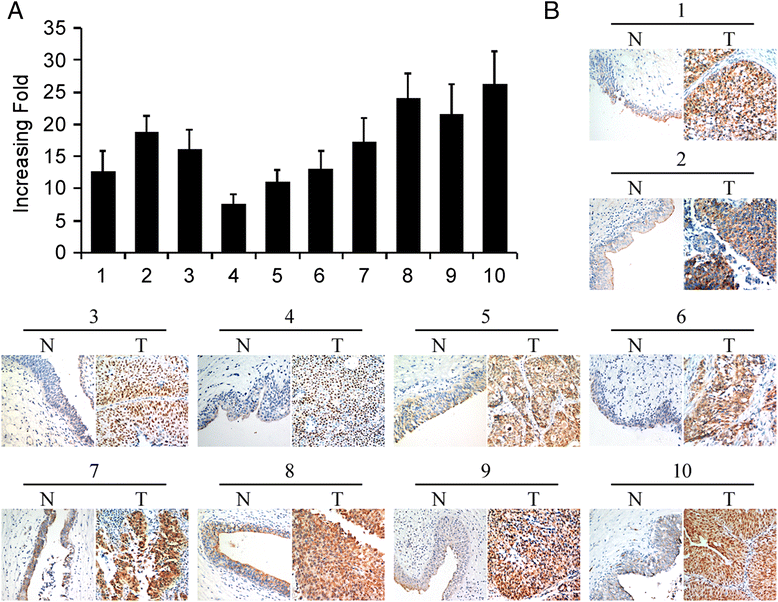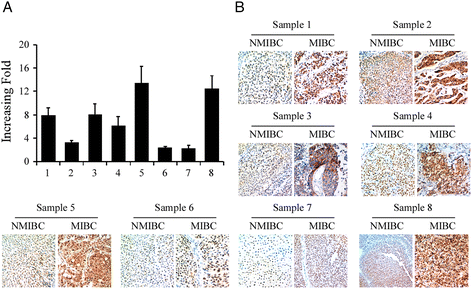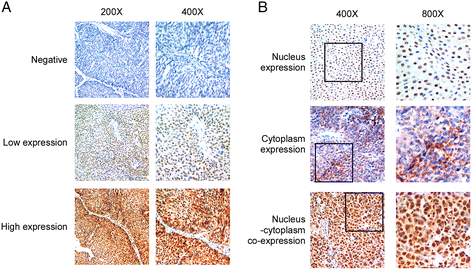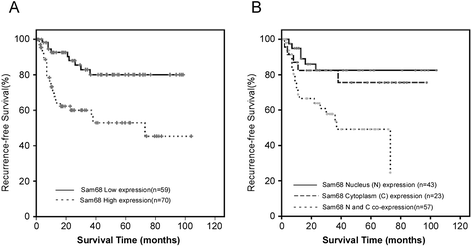Utility of SAM68 in the progression and prognosis for bladder cancer
- PMID: 25944080
- PMCID: PMC4425873
- DOI: 10.1186/s12885-015-1367-x
Utility of SAM68 in the progression and prognosis for bladder cancer
Abstract
Background: Muscle invasive bladder cancer (MIBC) is often lethal and non-MIBC (NMIBC) can recur and progress, yet prognostic markers are currently inadequate. SAM68, a member of RNA-binding proteins, has been reported to contribute to progression of other cancers. The aim of this study is to investigate the potential utility of SAM68 in the progression and prognosis of bladder cancer.
Methods: Quantitative PCR and immunohistochemistry were utilized to examine the expression of SAM68 in ten pairs of MIBC and adjacent normal bladder urothelium, and eight pairs of MIBC and non-MIBC (NMIBC) tissues from the same patient. Moreover, SAM68 protein expression level and localization were examined by immunohistochemistry in 129 clinicopathologically characterized MIBC samples. Prognostic associations were determined by multivariable analysis incorporating standard prognostic factors.
Results: SAM68 expression was elevated in MIBC tissues compared with adjacent normal bladder urothelium, and was increased at both transcriptional and translational levels in MIBC tissues compared with NMIBC tissues of the same patient. For MIBC, high expression and nucleus-cytoplasm co-expression of SAM68 were associated with higher T-stage, higher N-stage and worse recurrence-free survival. Five-year recurrence-free survival was 80% and 52.9% for MIBC patients with low and high SAM68 expression, respectively (p = 0.001). SAM68 nucleus-cytoplasm co-expression associated with worse 5-year recurrence-free survival rate (49.2%) than SAM68 expression confined to the nucleus (82.5%) or cytoplasm (75.5%) alone. On multivariable analysis SAM68 expression level, SAM68 nucleus-cytoplasm co-expression, T-stage, and N-stage were all independent prognostic factors for recurrence-free survival of MIBC patients.
Conclusions: SAM68 expression is increased in MIBC when compared to normal urothelium and NMIBC, and appears to be a potentially useful prognostic marker for MIBC.
Figures




Similar articles
-
Expression and cytoplasmic localization of SAM68 is a significant and independent prognostic marker for renal cell carcinoma.Cancer Epidemiol Biomarkers Prev. 2009 Oct;18(10):2685-93. doi: 10.1158/1055-9965.EPI-09-0097. Epub 2009 Sep 15. Cancer Epidemiol Biomarkers Prev. 2009. PMID: 19755649
-
Sam68 up-regulation correlates with, and its down-regulation inhibits, proliferation and tumourigenicity of breast cancer cells.J Pathol. 2010 Nov;222(3):227-37. doi: 10.1002/path.2751. J Pathol. 2010. PMID: 20662004
-
New insights into the influence of cigarette smoking on urothelial carcinogenesis: smoking-induced gene expression in tumor-free urothelium might discriminate muscle-invasive from nonmuscle-invasive urothelial bladder cancer.Mol Carcinog. 2012 Nov;51(11):907-15. doi: 10.1002/mc.20860. Epub 2011 Oct 4. Mol Carcinog. 2012. PMID: 21976419
-
Prognostic Implications of Immunohistochemical Biomarkers in Non-muscle-invasive Blad Cancer and Muscle-invasive Bladder Cancer.Mini Rev Med Chem. 2020;20(12):1133-1152. doi: 10.2174/1389557516666160512151202. Mini Rev Med Chem. 2020. PMID: 27173513 Review.
-
The RNA-binding protein Sam68 is a multifunctional player in human cancer.Endocr Relat Cancer. 2011 Jul 1;18(4):R91-R102. doi: 10.1530/ERC-11-0041. Print 2011 Aug. Endocr Relat Cancer. 2011. PMID: 21565971 Review.
Cited by
-
Low expression of protocadherin7 (PCDH7) is a potential prognostic biomarker for primary non-muscle invasive bladder cancer.Oncotarget. 2016 May 10;7(19):28384-92. doi: 10.18632/oncotarget.8635. Oncotarget. 2016. PMID: 27070091 Free PMC article.
-
Role of Sam68 in different types of cancer (Review).Int J Mol Med. 2025 Jan;55(1):3. doi: 10.3892/ijmm.2024.5444. Epub 2024 Oct 25. Int J Mol Med. 2025. PMID: 39450529 Free PMC article. Review.
-
The p53 status can influence the role of Sam68 in tumorigenesis.Oncotarget. 2016 Nov 1;7(44):71651-71659. doi: 10.18632/oncotarget.12305. Oncotarget. 2016. PMID: 27690217 Free PMC article.
-
Is APC hypermethylation a diagnostic biomarker for bladder cancer? A meta-analysis.Onco Targets Ther. 2018 Nov 27;11:8359-8369. doi: 10.2147/OTT.S177601. eCollection 2018. Onco Targets Ther. 2018. PMID: 30568459 Free PMC article.
-
A comprehensive study on genome-wide coexpression network of KHDRBS1/Sam68 reveals its cancer and patient-specific association.Sci Rep. 2019 Jul 31;9(1):11083. doi: 10.1038/s41598-019-47558-x. Sci Rep. 2019. PMID: 31366900 Free PMC article.
References
-
- Steinberg GD, Trump DL, Cummings KB. Metastatic bladder cancer. Natural history, clinical course, and consideration for treatment. Urol Clin North Am. 1992;19(4):735–46. - PubMed
-
- Liebert M, Seigne J. Characteristics of invasive bladder cancers: histological and molecular markers. Semin Urol Oncol. 1996;14(2):62–72. - PubMed
-
- Dimopoulos MA, Moulopoulos LA. Role of adjuvant chemotherapy in the treatment of invasive carcinoma of the urinary bladder. J Clin Oncol. 1998;16(4):1601–12. - PubMed
Publication types
MeSH terms
Substances
LinkOut - more resources
Full Text Sources
Other Literature Sources
Medical

